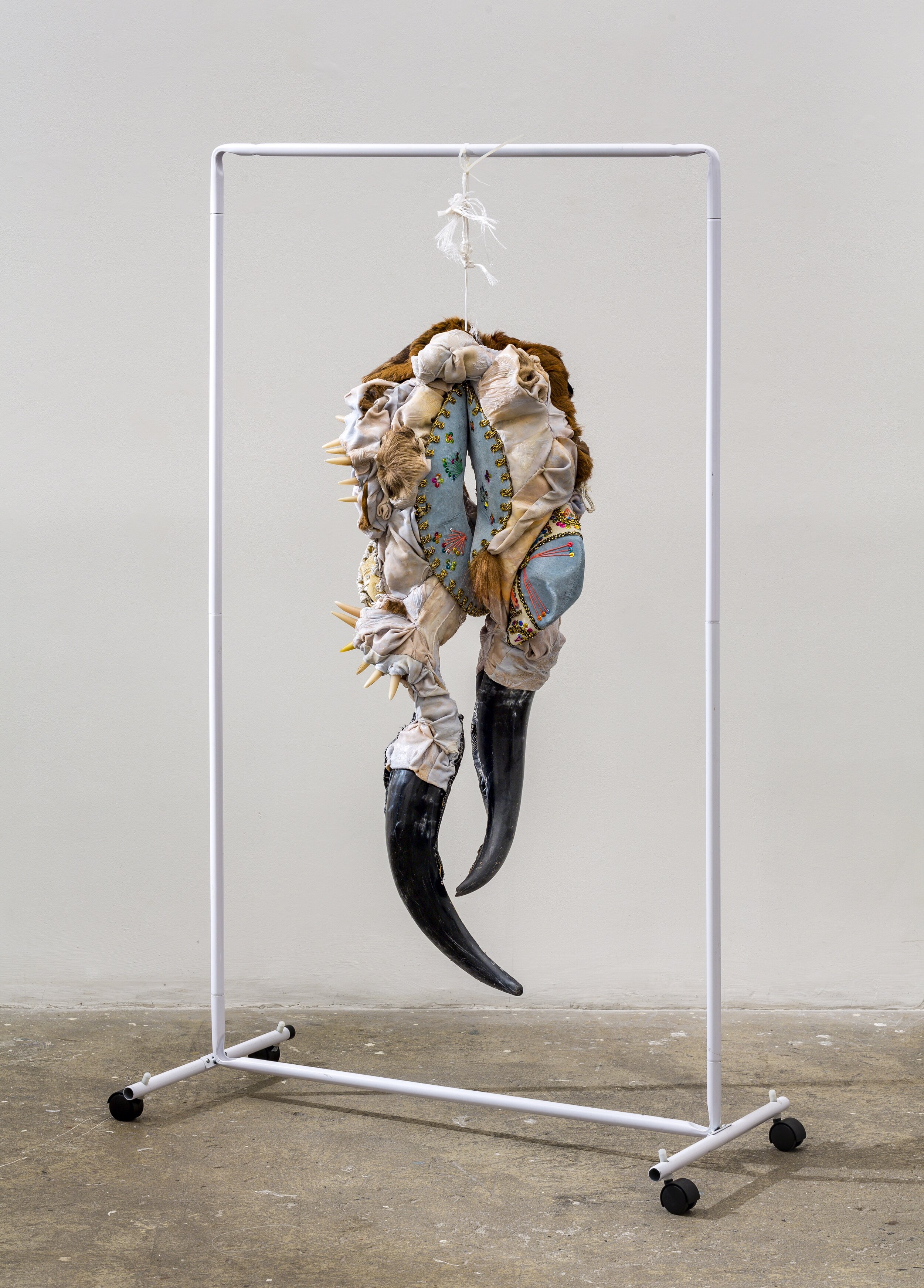Ruben Ulises Rodriguez Montoya | Inside the Bowels of the Hoofed Beast
September 18 - October 25, 2020
Ruben Ulises Rodriguez Montoya | Inside the Bowels of the Hoofed Beast
September 18 - October 25, 2020
Ruben Ulises Rodriguez Montoya’s sculptures seem possessed. They haunt the viewer. Pressing questions of origin and familiarity, and transfixed with an uncanny foreignness, these figures elicit both awe and fear.
Montoya’s sublime beings are reminiscent of a Rasquache aesthetic, of collecting from here and there, brought to flesh from the abject and forgotten detritus of the desert surrounding the United States-Mexico border. These calculated gestures then become anthropomorphized and give birth to these otherworldly, illegitimate offspring; while zip ties, brooms, and twine keep these beings tied to this world as vestiges of Brown labor.
Like a curandero, he alters daily discarded forms into enchanting beasts, which shapeshift and take on their own form, like fateful nahuales who transform into jaguars.
His sculptures seem to emerge as incantations from toxic waste, reincarnated now as spiritual guides. Montoya’s bodies, therefore, subsume this landscape of refuse onto themselves: neon green zip ties and cybernetic circuit boards support their spines, clothes become repurposed as organs, and silicone is transformed to skin. The animal, the human, and the artificial become one.
Montoya’s sculptures are bound, contorted and reconfigured in such a way that they become exquisite corpses, invoking yet transcending our traditional forms of the body. In this liminal space, they demand a second look—not as alien messengers, but as reflections of ourselves and our fractured social landscape.
Text by Christal Pérez
Ruben Ulises Rodriguez Montoya (b. 1989, Parral. Chihuahua, Mexico) recently graduated from Virginia Commonwealth University with an MFA in Sculpture + Extended Media in 2020. He is currently part of a group show titled “new waves” at Virginia MOCA. He has also exhibited at Residency Art Gallery, Inglewood, CA and Commonwealth and Council, Los Angeles, CA. This is his first solo exhibition.
*Rasquache- Using discarded and often found objects of the everyday to create the most from the least.
*Curandero - A healer that cures illness with herbs and spiritual cleansings.
*Nahual - In Mesoamerican tradition - a person able to shapeshift into an animal.
Ruben Ulises Rodriguez Montoya | En las Entrañas de la Bestia con Pezuñas
September 18 - October 25, 2020
Las esculturas de Rubén Ulises Rodríguez Montoya parecen estar poseídas. Hechizan a cualquiera que las vea. En ellas urgen las preguntas del origen y la familiaridad, y paralizadas con un misterio inusual, estas figuras obtienen asombro y miedo.
Los seres sublimes de Montoya son reminiscentes de las estéticas del rasquachismo, de recoger de aquí y de allá, hechas carne y hueso de lo abyecto y del detrito olvidado del desierto que rodea la frontera de los Estados Unidos y México. Estos gestos calculados se antropomorfizan y dan a luz a la cría fantasmal ilegítima, mientras que bridas, escobas, y cuerda mantienen a esos seres atados a este mundo como vestigios de la labor de cuerpos morenos.
Como un curandero, Montoya altera las cosas que tiramos diariamente y hace que las formas desechadas se conviertan en bestias embrujadoras, las cuales cambian de forma y toman su propia silueta. Como los fieles nahuales que se convierten en jaguares.
Sus esculturas parecen surgir de los residuos tóxicos como encantamientos, conjuros ahora reencarnados como guías espirituales. Los cuerpos de Montoya, por lo tanto, subsumen en si mismos este paisaje lleno de desperdicio: bridas de neón y placas de circuito cibernético ayudan a sostener sus columnas vertebrales, la ropa es reutilizada para convertirla en órganos vitales, y el silicón es transformado en piel. La fiera, lo humano, y lo artificial hechos uno.
Atadas, las esculturas de Montoya se retuercen y se reconfiguran de tal manera que se convierten en cadáveres exquisitos, invocando y a la vez excediendo nuestras formas tradicionales del cuerpo. En este espacio liminal, ellas exigen otra mirada—no como extraterrestres mensajeros, pero como reflexiones de nosotros mismos y de nuestro paisaje social fracturado.
Texto de Christal Pérez








